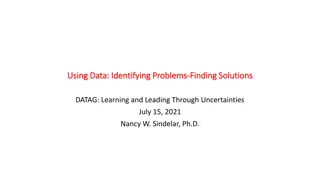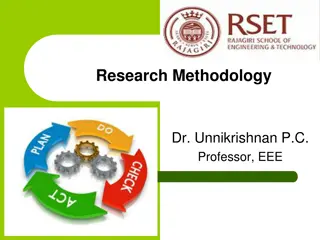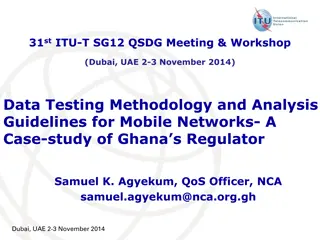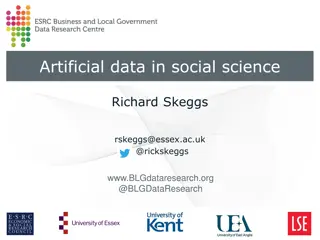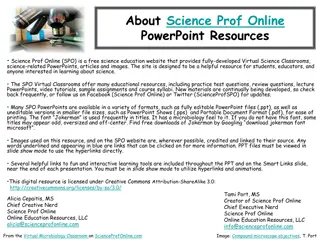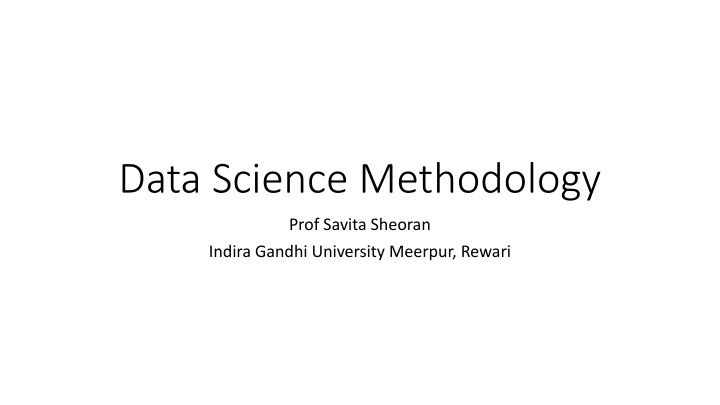
Data Science Methodology for Problem Solving with Savita Sheoran at Indira Gandhi University
"Explore the systematic approach to problem-solving through data science methodology with Prof. Savita Sheoran at Indira Gandhi University in Meerpur, Rewari. Learn about key steps like problem definition, data collection, cleaning, preprocessing, and model deployment. Dive into understanding business needs, formulating hypotheses, setting goals, and iterating for refinement. Enhance your data-driven decision-making skills in this interdisciplinary field." (449 characters)
Download Presentation

Please find below an Image/Link to download the presentation.
The content on the website is provided AS IS for your information and personal use only. It may not be sold, licensed, or shared on other websites without obtaining consent from the author. If you encounter any issues during the download, it is possible that the publisher has removed the file from their server.
You are allowed to download the files provided on this website for personal or commercial use, subject to the condition that they are used lawfully. All files are the property of their respective owners.
The content on the website is provided AS IS for your information and personal use only. It may not be sold, licensed, or shared on other websites without obtaining consent from the author.
E N D
Presentation Transcript
Data Science Methodology Prof Savita Sheoran Indira Gandhi University Meerpur, Rewari
Introduction Data science is a systematic approach to solving problems using data. It involves extracting meaningful insights from structured and unstructured data, and making data-driven decisions. The process is often iterative and involves various stages that refine understanding, identify patterns, and build predictive models. While data science is highly interdisciplinary and depends on the context, most data science projects follow a methodology that includes a series of steps. Below, we ll outline a typical data science methodology, which can be adapted to specific problems or industries.
M Methodology ethodology that includes a series of steps. 1. Problem Definition 2. Data Collection 3. Data Cleaning and Preprocessing 4. Exploratory Data Analysis (EDA) 5. Model Selection 6. Model Training and Evaluation 7. Model Deployment 8. Communication and Reporting 9. Iteration and Refinement
Problem Definition The first and most important step in any data science project is defining the problem. Without a clear problem statement, the project is likely to go off-track. Key Tasks: Understand Business Needs: Meet with stakeholders to understand the business problem, project objectives, and expected outcomes. Formulate Hypotheses: Develop initial hypotheses about the problem based on domain knowledge, previous research, or data. Set Goals: Define measurable goals (e.g., improve sales, reduce churn, increase efficiency) and KPIs (Key Performance Indicators). Example: If a business wants to reduce customer churn, the problem might be defined as: "Predict which customers are likely to churn, so we can target them with retention strategies.
Data Collection Once the problem is defined, the next step is to gather the data that will help answer the business question. Data can come from various sources such as databases, APIs, surveys, sensors, logs, or public datasets. Key Tasks: Identify Data Sources: Determine where the relevant data exists. This could include internal company databases, online datasets, or external data sources. Data Acquisition: Extract data from these sources using tools like APIs, web scraping, or accessing databases (SQL, NoSQL). Data Privacy and Compliance: Ensure that data collection respects privacy laws (e.g., GDPR) and ethical considerations. Example: In the churn prediction example, relevant data might include customer demographics, purchase history, interaction logs, and service usage.
Data Cleaning and Preprocessing Once the data is collected, it s time for data cleaning and preprocessing. This step is crucial because real-world data is often messy, incomplete, and inconsistent. The quality of the data can significantly affect the quality of the model. Key Tasks: Handle Missing Data: Impute missing values or remove rows/columns with too much missing data. Remove Duplicates: Ensure there are no duplicate records in the dataset. Handle Outliers: Identify and handle outliers that might distort the model. Data Transformation: Normalize or scale data for algorithms that require specific data formats (e.g., machine learning models). Feature Engineering: Create new features (variables) that could enhance the predictive power of the model. Example: If customer age or income data is missing, you may decide to impute values based on the median or remove customers with missing key variables. If data is on different scales (e.g., age vs. income), scaling may be necessary.
Exploratory Data Analysis (EDA) EDA is the process of analyzing data sets to summarize their main characteristics and gain a deeper understanding of the patterns, relationships, and anomalies within the data. Key Tasks: Univariate Analysis: Analyze each feature individually (e.g., histograms, box plots) to understand its distribution and identify issues like skewness or outliers. Bivariate and Multivariate Analysis: Explore relationships between two or more features (e.g., correlation matrices, scatter plots, pair plots). Visualization: Use graphs and charts (e.g., bar charts, heatmaps, line plots) to visually identify patterns, trends, and potential problems. Initial Insights: Make initial conclusions about the data s structure and how it may be related to the problem. Example: In the churn prediction case, EDA could reveal that younger customers are more likely to churn, or that customers who interact less with customer service tend to leave more often.
Model Selection With the data cleaned and analyzed, the next step is to choose appropriate models to solve the problem. Depending on the task, the model could be a classification algorithm, regression model, clustering method, or something else entirely. Key Tasks: Select Algorithms: Choose the most suitable algorithms based on the problem (e.g., logistic regression for binary classification, decision trees for interpretability, k-means clustering for segmentation). Train/Test Split: Split the dataset into training and testing sets to evaluate model performance. Feature Selection: Identify the most relevant features to use in the model. This reduces dimensionality and improves model performance. Model Validation: Use techniques like cross-validation to ensure the model generalizes well to unseen data. Example: For churn prediction, a logistic regression model could predict whether a customer will churn (binary outcome: yes/no). Alternatively, a random forest model might be used if there are complex, non-linear relationships between features.
Model Training and Evaluation After selecting a model, the next step is to train the model on the data and then evaluate its performance. Key Tasks: Train the Model: Use the training data to fit the model and learn from the data. Model Evaluation Metrics: Evaluate the model using appropriate metrics based on the problem type: Classification Metrics: Accuracy, Precision, Recall, F1-Score, AUC-ROC. Regression Metrics: Mean Squared Error (MSE), Mean Absolute Error (MAE), R-squared. Hyperparameter Tuning: Fine-tune model parameters to improve performance (e.g., adjusting learning rate, number of trees, or regularization strength). Model Comparison: Compare different models to determine the best-performing one. Example: In churn prediction, you may use accuracy and AUC-ROC to evaluate the performance of your logistic regression or random forest model. Hyperparameter tuning could involve adjusting the number of trees in the random forest.
Model Deployment Once a model is trained and evaluated, it is time to deploy the model into production. This allows the model to make predictions in real-time or batch mode based on new data. Key Tasks: Deployment Strategy: Choose how the model will be deployed. It could be embedded into an application, deployed via a cloud service, or used to generate batch predictions. Monitoring and Maintenance: Monitor the model s performance over time. Ensure it continues to make accurate predictions and retrain it if the data distribution changes (data drift). Scalability: Ensure the model can handle large volumes of incoming data if needed. Example: In churn prediction, the deployed model could predict customer churn on a daily basis and trigger automated retention actions, such as offering discounts or sending personalized messages.
Communication and Reporting Effective communication is key to ensuring that the insights and models you ve built are actionable for stakeholders. Key Tasks: Data Visualization: Present key insights from the data analysis and model evaluation through charts, graphs, and dashboards. Report Generation: Write clear reports that describe the methodology, results, and implications of the analysis. Presentation: Present findings to stakeholders and provide actionable recommendations based on data insights. Example: For churn prediction, you might present to the business team that "customers aged 25-30 who haven t interacted with customer service in the past six months have a 15% higher chance of churning." Then, provide recommendations to target these customers with retention efforts.
Iteration and Refinement Data science is an iterative process. After deployment, feedback and new data should be used to refine and improve the model. Key Tasks: Retraining the Model: Use new data to retrain the model and improve its performance. Incorporating Feedback: Gather feedback from stakeholders about how the model is being used and any shortcomings. Continuous Improvement: Continuously monitor model performance and explore new algorithms or features that may improve accuracy. Example: If the churn prediction model is performing well initially, but stakeholders notice that certain customer segments are not accurately predicted, additional features or data may be incorporated to refine the model.



